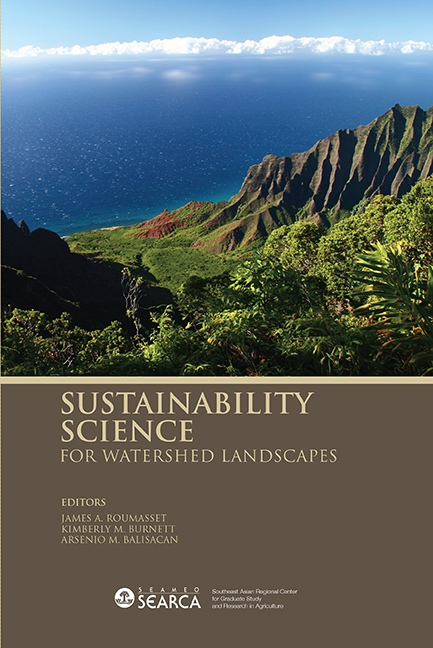Book contents
- Frontmatter
- Contents
- Tables
- Figures
- Message
- Foreword
- Preface
- Acknowledgments
- List of Contributors
- Theme 1 Sustainability Science for Resource Management and Policy
- Theme 2 Monitoring and Modelling
- 5 Cyberinfrastructure for Sustainability in Coupled Human – Environment Systems
- 6 Watershed Management for Sustainability in Tropical Watersheds: An Integrated Hydrologic Modelling Approach
- 7 Watershed Assessment, Restoration, and Protection in Hawaiʿi
- Theme 3 Participatory Approaches
- Theme 4 Case Studies
- Synthesis
7 - Watershed Assessment, Restoration, and Protection in Hawaiʿi
from Theme 2 - Monitoring and Modelling
Published online by Cambridge University Press: 21 October 2015
- Frontmatter
- Contents
- Tables
- Figures
- Message
- Foreword
- Preface
- Acknowledgments
- List of Contributors
- Theme 1 Sustainability Science for Resource Management and Policy
- Theme 2 Monitoring and Modelling
- 5 Cyberinfrastructure for Sustainability in Coupled Human – Environment Systems
- 6 Watershed Management for Sustainability in Tropical Watersheds: An Integrated Hydrologic Modelling Approach
- 7 Watershed Assessment, Restoration, and Protection in Hawaiʿi
- Theme 3 Participatory Approaches
- Theme 4 Case Studies
- Synthesis
Summary
ABSTRACT
This study evaluated efforts on watershed assessment, restoration, and preparation of protection plans as cornerstones of resource sustainability. The assessment presented a specific study in the Nāwiliwili Watershed, Kauaʿi, Hawaiʿi, USA. The proposed restoration and protection plan covered the nine elements required by the U.S. Environmental Protection Agency for watershed-based plans for impaired waters. The elements can be grouped into five categories: identification of sources and level of contaminants, design of restoration and protection strategies including estimation of expected reduction of contaminant levels, information and educational programme development, assessment of the financial implications of the plan, and setting up of guidelines to manage the plan. The discussion also includes limitations of the plan and its suitability to address sustainability issues.
INTRODUCTION
According to the US Environmental Protection Agency (EPA), over 40 percent of assessed waters in the United States do not meet water quality standards set by the local jurisdictions, including states, territories, and authorised tribes. The number of water bodies affected exceeds 20,000 individual river segments, lakes, and estuaries. These impaired waters include approximately 300,000 miles of rivers and shorelines and approximately 5 M acres of lakes. An overwhelming majority of the population - 218 M - lives within 10 miles of the impaired waters. Sediments, excess nutrients, and harmful microorganisms result in quality impairment. Local governments are required to develop lists of these impaired waters and establish priority rankings for waters on the lists and develop total maximum daily loads (TMDLs) for these waters. A TMDL specifies the maximum amount of a pollutant that a water body can receive and still meet water quality standards, and allocates pollutant loadings among point and nonpoint pollutant sources. By law, EPA must approve or disapprove the lists and the TMDLs established by the local governments. If the submission is inadequate, EPA must establish the list or the TMDL.
- Type
- Chapter
- Information
- Sustainability Science for Watershed Landscapes , pp. 167 - 192Publisher: ISEAS–Yusof Ishak InstitutePrint publication year: 2010



